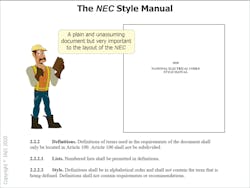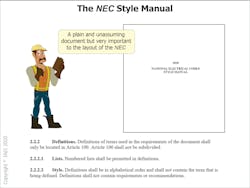Guidelines for Writing the National Electrical Code
Writing a book is usually limited to a single author, and the writing style is determined by that author. The National Fire Protection Association (NFPA) publishes many standards, and the actual authors are members of Technical Committees.
NFPA has developed guidelines for all their standards under a standards development process. The “Manual of Style for NFPA Technical Committee Documents” applies to all NFPA Standards and is often referred to as the “NFPA Manual of Style.” The current edition was published in July 2004. The NFPA Manual of Style provides guidelines to keep the document written in a logical order. The purpose of the Style Manual is to assist the Technical Committees in providing a standard that is clear, usable, and as unambiguous as possible.
The National Electrical Code (NEC) has its own Style Manual. The NEC Style Manual only applies to the NEC and NFPA 70E, The Standard for Electrical Safety in the Workplace.
Authors of the NEC
The NEC references its Technical Committees as Code-Making Panels (CMPs). There are 18 CMPs plus the Correlating Committee that oversees the work of these panels. There are about 500 people involved in the Code-making process along with thousands of interested people from the electrical industry and the public that also provide input on changes for the NEC through Public Inputs and Public Comments processes.
The 2020 edition of the NEC Style Manual was drafted by the Usability Task Group of the NEC Correlating Committee and approved by the NEC Correlating Committee and the NFPA Standards Council. This edition of the Style Manual was used for the 2023 edition of the NEC.
The 2020 Style Manual made some important changes that affect the arrangement and writing style for the 2023 NEC. The most notable is with the definitions. Previous editions of the Code had definitions throughout the body of the Code. A definition could be in a Code section, in an Article, and (if used in more than one Article) it would be found in Art. 100 [Definitions].
The 2020 NEC Art. 100 definitions were separated into three parts: General, Over 1,000V, and Hazardous Locations. The revisions to the Style Manual require all definitions in the NEC to be located in Art. 100, arranged in alphabetical order, and not subdivided into Parts. Definitions are not permitted to contain the term being defined or have requirements or recommendations in the definition. After moving the definitions to Art. 100, it was evident there were multiple defined terms used differently in various Articles in the Code. Many of the terms were grouped by a base term then separated by a comma and then a modifying descriptor [e.g., Conduit, Rigid Metal (RMC). (Rigid Metal Conduit)]. An acronym is permitted in the Style Manual and (when used in the defined term) that acronym is permitted to be used anywhere in the document without using the complete term. A searchable term in parentheses is added when the defined term is not in the manner usually found within the document.
The definitions apply throughout the document unless an Article number is listed after the definition to inform the user that the term only applies to a specific Article. The term “Child Care Facility” is a definition that only pertains to receptacle requirements, and the Article number is listed in parentheses after the definition [e.g., (406)]. The Correlating Committee assigns the responsibility of the various terms in the NEC and that designation is included after the definition, (CMP-18).
Multiple definitions for the same term having different meanings are currently being addressed by the CMPs. They’ve been asked to try and resolve the issue by “massaging” the wording to come up with a single definition. There are instances where this is not possible, including existing terms Accessible (as applied to equipment) and Accessible (as applied to wiring methods).
Similar or alternate terms are permitted to be added to a defined term. The term “Recreational Vehicle” now includes some terms that were previously listed with separate definitions. Having only one definition and including similar terms provide additional clarity and conciseness to the document [e.g., Recreational Vehicle (RV). (Camping Trailer) (Motor Home) (Travel Trailer) (Truck Camper)].
Moving all the definitions into Art. 100 was a huge task for the Code-Making Panels. Their work in this area is ongoing, and fine-tuning will take place in future editions of the Code. The 2020 NEC has about 300 definitions in the three parts of Art. 100. The 2023 Code will have just short of 800 definitions.
Inspector Intel articles are provided by the International Association of Electrical Inspectors (IAEI), www.iaei.org, a membership-driven, non-profit association headquartered in Richardson, Texas, that promotes electrical safety throughout the industry by providing education, certification of inspectors, advocacy, partnerships, and expert leadership in electrical codes and standards.
David Williams is the electrical inspector for Delta Township in Lansing, Mich. He has served the electrical industry since 1974, and has been an inspector for over 30 years. He serves on the NFPA NEC Correlating Committee, NFPA NEC CMP-10, and NFPA 99. David is an IAEI Board of Directors, member of the UL Electrical Council, and Associate Professor at Lansing Community College. He can be reached at [email protected].
About the Author
David Williams
David Williams is the Electrical Inspector for Delta Township in Lansing, Mich. He has served the electrical industry since 1974, and as an inspector for over 30 years. He serves on the NFPA NEC Correlating Committee, NFPA NEC CMP-10 and NFPA 99. David is an IAEI Board of Directors, member of the UL Electrical Council and Associate Professor at Lansing Community College.

